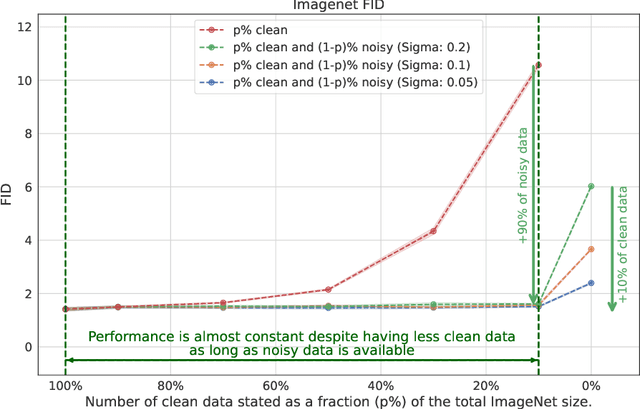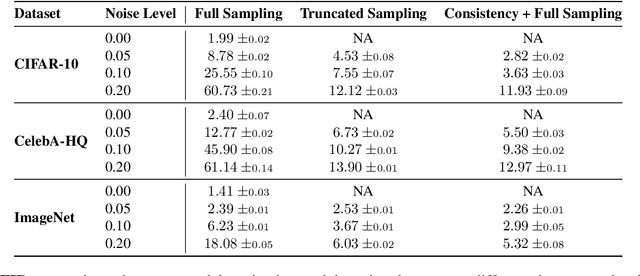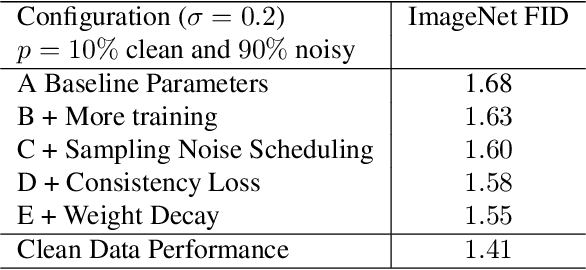Constantinos Daskalakis
DiffEM: Learning from Corrupted Data with Diffusion Models via Expectation Maximization
Oct 14, 2025Abstract:Diffusion models have emerged as powerful generative priors for high-dimensional inverse problems, yet learning them when only corrupted or noisy observations are available remains challenging. In this work, we propose a new method for training diffusion models with Expectation-Maximization (EM) from corrupted data. Our proposed method, DiffEM, utilizes conditional diffusion models to reconstruct clean data from observations in the E-step, and then uses the reconstructed data to refine the conditional diffusion model in the M-step. Theoretically, we provide monotonic convergence guarantees for the DiffEM iteration, assuming appropriate statistical conditions. We demonstrate the effectiveness of our approach through experiments on various image reconstruction tasks.
Ambient Diffusion Omni: Training Good Models with Bad Data
Jun 10, 2025Abstract:We show how to use low-quality, synthetic, and out-of-distribution images to improve the quality of a diffusion model. Typically, diffusion models are trained on curated datasets that emerge from highly filtered data pools from the Web and other sources. We show that there is immense value in the lower-quality images that are often discarded. We present Ambient Diffusion Omni, a simple, principled framework to train diffusion models that can extract signal from all available images during training. Our framework exploits two properties of natural images -- spectral power law decay and locality. We first validate our framework by successfully training diffusion models with images synthetically corrupted by Gaussian blur, JPEG compression, and motion blur. We then use our framework to achieve state-of-the-art ImageNet FID, and we show significant improvements in both image quality and diversity for text-to-image generative modeling. The core insight is that noise dampens the initial skew between the desired high-quality distribution and the mixed distribution we actually observe. We provide rigorous theoretical justification for our approach by analyzing the trade-off between learning from biased data versus limited unbiased data across diffusion times.
Learning High-dimensional Gaussians from Censored Data
Apr 28, 2025Abstract:We provide efficient algorithms for the problem of distribution learning from high-dimensional Gaussian data where in each sample, some of the variable values are missing. We suppose that the variables are missing not at random (MNAR). The missingness model, denoted by $S(y)$, is the function that maps any point $y$ in $R^d$ to the subsets of its coordinates that are seen. In this work, we assume that it is known. We study the following two settings: (i) Self-censoring: An observation $x$ is generated by first sampling the true value $y$ from a $d$-dimensional Gaussian $N(\mu*, \Sigma*)$ with unknown $\mu*$ and $\Sigma*$. For each coordinate $i$, there exists a set $S_i$ subseteq $R^d$ such that $x_i = y_i$ if and only if $y_i$ in $S_i$. Otherwise, $x_i$ is missing and takes a generic value (e.g., "?"). We design an algorithm that learns $N(\mu*, \Sigma*)$ up to total variation (TV) distance epsilon, using $poly(d, 1/\epsilon)$ samples, assuming only that each pair of coordinates is observed with sufficiently high probability. (ii) Linear thresholding: An observation $x$ is generated by first sampling $y$ from a $d$-dimensional Gaussian $N(\mu*, \Sigma)$ with unknown $\mu*$ and known $\Sigma$, and then applying the missingness model $S$ where $S(y) = {i in [d] : v_i^T y <= b_i}$ for some $v_1, ..., v_d$ in $R^d$ and $b_1, ..., b_d$ in $R$. We design an efficient mean estimation algorithm, assuming that none of the possible missingness patterns is very rare conditioned on the values of the observed coordinates and that any small subset of coordinates is observed with sufficiently high probability.
Fixed Point Computation: Beating Brute Force with Smoothed Analysis
Jan 18, 2025Abstract:We propose a new algorithm that finds an $\varepsilon$-approximate fixed point of a smooth function from the $n$-dimensional $\ell_2$ unit ball to itself. We use the general framework of finding approximate solutions to a variational inequality, a problem that subsumes fixed point computation and the computation of a Nash Equilibrium. The algorithm's runtime is bounded by $e^{O(n)}/\varepsilon$, under the smoothed-analysis framework. This is the first known algorithm in such a generality whose runtime is faster than $(1/\varepsilon)^{O(n)}$, which is a time that suffices for an exhaustive search. We complement this result with a lower bound of $e^{\Omega(n)}$ on the query complexity for finding an $O(1)$-approximate fixed point on the unit ball, which holds even in the smoothed-analysis model, yet without the assumption that the function is smooth. Existing lower bounds are only known for the hypercube, and adapting them to the ball does not give non-trivial results even for finding $O(1/\sqrt{n})$-approximate fixed points.
Charting the Shapes of Stories with Game Theory
Dec 07, 2024Abstract:Stories are records of our experiences and their analysis reveals insights into the nature of being human. Successful analyses are often interdisciplinary, leveraging mathematical tools to extract structure from stories and insights from structure. Historically, these tools have been restricted to one dimensional charts and dynamic social networks; however, modern AI offers the possibility of identifying more fully the plot structure, character incentives, and, importantly, counterfactual plot lines that the story could have taken but did not take. In this work, we use AI to model the structure of stories as game-theoretic objects, amenable to quantitative analysis. This allows us to not only interrogate each character's decision making, but also possibly peer into the original author's conception of the characters' world. We demonstrate our proposed technique on Shakespeare's famous Romeo and Juliet. We conclude with a discussion of how our analysis could be replicated in broader contexts, including real-life scenarios.
How much is a noisy image worth? Data Scaling Laws for Ambient Diffusion
Nov 05, 2024



Abstract:The quality of generative models depends on the quality of the data they are trained on. Creating large-scale, high-quality datasets is often expensive and sometimes impossible, e.g. in certain scientific applications where there is no access to clean data due to physical or instrumentation constraints. Ambient Diffusion and related frameworks train diffusion models with solely corrupted data (which are usually cheaper to acquire) but ambient models significantly underperform models trained on clean data. We study this phenomenon at scale by training more than $80$ models on data with different corruption levels across three datasets ranging from $30,000$ to $\approx 1.3$M samples. We show that it is impossible, at these sample sizes, to match the performance of models trained on clean data when only training on noisy data. Yet, a combination of a small set of clean data (e.g.~$10\%$ of the total dataset) and a large set of highly noisy data suffices to reach the performance of models trained solely on similar-size datasets of clean data, and in particular to achieve near state-of-the-art performance. We provide theoretical evidence for our findings by developing novel sample complexity bounds for learning from Gaussian Mixtures with heterogeneous variances. Our theoretical model suggests that, for large enough datasets, the effective marginal utility of a noisy sample is exponentially worse than that of a clean sample. Providing a small set of clean samples can significantly reduce the sample size requirements for noisy data, as we also observe in our experiments.
Maximizing utility in multi-agent environments by anticipating the behavior of other learners
Jul 05, 2024
Abstract:Learning algorithms are often used to make decisions in sequential decision-making environments. In multi-agent settings, the decisions of each agent can affect the utilities/losses of the other agents. Therefore, if an agent is good at anticipating the behavior of the other agents, in particular how they will make decisions in each round as a function of their experience that far, it could try to judiciously make its own decisions over the rounds of the interaction so as to influence the other agents to behave in a way that ultimately benefits its own utility. In this paper, we study repeated two-player games involving two types of agents: a learner, which employs an online learning algorithm to choose its strategy in each round; and an optimizer, which knows the learner's utility function and the learner's online learning algorithm. The optimizer wants to plan ahead to maximize its own utility, while taking into account the learner's behavior. We provide two results: a positive result for repeated zero-sum games and a negative result for repeated general-sum games. Our positive result is an algorithm for the optimizer, which exactly maximizes its utility against a learner that plays the Replicator Dynamics -- the continuous-time analogue of Multiplicative Weights Update (MWU). Additionally, we use this result to provide an algorithm for the optimizer against MWU, i.e.~for the discrete-time setting, which guarantees an average utility for the optimizer that is higher than the value of the one-shot game. Our negative result shows that, unless P=NP, there is no Fully Polynomial Time Approximation Scheme (FPTAS) for maximizing the utility of an optimizer against a learner that best-responds to the history in each round. Yet, this still leaves open the question of whether there exists a polynomial-time algorithm that optimizes the utility up to $o(T)$.
Improved bounds for calibration via stronger sign preservation games
Jun 19, 2024Abstract:A set of probabilistic forecasts is calibrated if each prediction of the forecaster closely approximates the empirical distribution of outcomes on the subset of timesteps where that prediction was made. We study the fundamental problem of online calibrated forecasting of binary sequences, which was initially studied by Foster & Vohra (1998). They derived an algorithm with $O(T^{2/3})$ calibration error after $T$ time steps, and showed a lower bound of $\Omega(T^{1/2})$. These bounds remained stagnant for two decades, until Qiao & Valiant (2021) improved the lower bound to $\Omega(T^{0.528})$ by introducing a combinatorial game called sign preservation and showing that lower bounds for this game imply lower bounds for calibration. We introduce a strengthening of Qiao & Valiant's game that we call sign preservation with reuse (SPR). We prove that the relationship between SPR and calibrated forecasting is bidirectional: not only do lower bounds for SPR translate into lower bounds for calibration, but algorithms for SPR also translate into new algorithms for calibrated forecasting. In particular, any strategy that improves the trivial upper bound for the value of the SPR game would imply a forecasting algorithm with calibration error exponent less than 2/3, improving Foster & Vohra's upper bound for the first time. Using similar ideas, we then prove a slightly stronger lower bound than that of Qiao & Valiant, namely $\Omega(T^{0.54389})$. Our lower bound is obtained by an oblivious adversary, marking the first $\omega(T^{1/2})$ calibration lower bound for oblivious adversaries.
Is Efficient PAC Learning Possible with an Oracle That Responds 'Yes' or 'No'?
Jun 18, 2024Abstract:The empirical risk minimization (ERM) principle has been highly impactful in machine learning, leading both to near-optimal theoretical guarantees for ERM-based learning algorithms as well as driving many of the recent empirical successes in deep learning. In this paper, we investigate the question of whether the ability to perform ERM, which computes a hypothesis minimizing empirical risk on a given dataset, is necessary for efficient learning: in particular, is there a weaker oracle than ERM which can nevertheless enable learnability? We answer this question affirmatively, showing that in the realizable setting of PAC learning for binary classification, a concept class can be learned using an oracle which only returns a single bit indicating whether a given dataset is realizable by some concept in the class. The sample complexity and oracle complexity of our algorithm depend polynomially on the VC dimension of the hypothesis class, thus showing that there is only a polynomial price to pay for use of our weaker oracle. Our results extend to the agnostic learning setting with a slight strengthening of the oracle, as well as to the partial concept, multiclass and real-valued learning settings. In the setting of partial concept classes, prior to our work no oracle-efficient algorithms were known, even with a standard ERM oracle. Thus, our results address a question of Alon et al. (2021) who asked whether there are algorithmic principles which enable efficient learnability in this setting.
Near-Optimal Learning and Planning in Separated Latent MDPs
Jun 12, 2024Abstract:We study computational and statistical aspects of learning Latent Markov Decision Processes (LMDPs). In this model, the learner interacts with an MDP drawn at the beginning of each epoch from an unknown mixture of MDPs. To sidestep known impossibility results, we consider several notions of separation of the constituent MDPs. The main thrust of this paper is in establishing a nearly-sharp *statistical threshold* for the horizon length necessary for efficient learning. On the computational side, we show that under a weaker assumption of separability under the optimal policy, there is a quasi-polynomial algorithm with time complexity scaling in terms of the statistical threshold. We further show a near-matching time complexity lower bound under the exponential time hypothesis.
 Add to Chrome
Add to Chrome Add to Firefox
Add to Firefox Add to Edge
Add to Edge